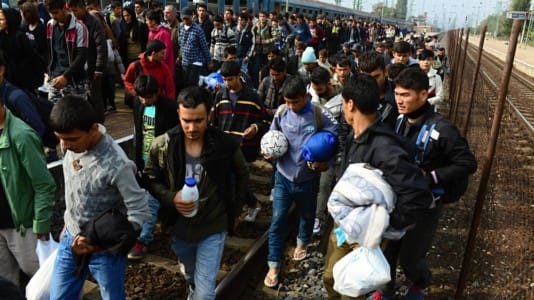Germany is once again resorting to tent camps as cities and municipalities enter crisis mode over the country’s soaring immigration numbers. At the same time, housing and rental prices continue to spike across Germany despite the economic contraction and high interest rates.
As the population has grown to a record 84 million, even Germany’s unparalleled system of shelters and social housing, which it has built up over the last 10 years to deal with unrelenting immigration, is unable to absorb all the newcomers. Now, local governments are turning to tents, gyms, and hotels all at a time when polling shows a majority of the German public is saying too many migrants are arriving.
[pp id=66839]
As German newspaper Die Welt notes, the core problem is not necessarily that over 1.3 million people entered Germany last year, with the lion’s share refugees from Ukraine, but that all the previous waves of refugees refuse to return home.
“It would be no problem at all if large groups of refugees from past wars or persecutions, and even more so, rejected asylum seekers or criminals, were to return home again and again,” writes Die Welt. “But a web of legal claims makes it difficult to set up a sustainable organization of immigration. Once a person has been recognized, he or she usually receives an enforceable claim to permanent residence after only three to five years. The traffic light government even wants naturalization after this short period. In addition, the majority of rejected asylum seekers remain.”
[pp id=62869]
As Die Welt reports, the country’s left-wing government is working to ensure that all newcomers, many of who are entitled to temporary protection, are able to not only stay in the country indefinitely but also be able to vote. The unspoken benefit is that the vast majority of these newcomers will be voting for the parties that made it easier for them to obtain citizenship and bring their families to Germany.
Germany more crowded than ever
Germany is now more crowded than ever, and in turn, it is driving up housing and rental prices to record highs. Christian Engelhardt, the district administrator of Bergstrasse County in Hesse, notes that housing is growing perilous: “Even citizens who want to move to our county because of a well-paying job can hardly find affordable housing. Because of the shortage, some of the refugees assigned to us since 2015 still haven’t come out of the collective accommodations.”
Last year, he said another 4,000 people were added to his municipality, saying, “That’s more than the inhabitants of our smallest municipality in the district.”
[pp id=61964]
Engelhardt was forced to set up a tent city with 1,000 spots, and another one is planned. He notes that it is “completely illusory” that these people will be able to find affordable housing, as almost all cities and towns in German are facing the same problems.
Housing costs have soared over recent years as Germany’s population has grown, rising an average of 9.1 percent each year over the last five years. Now, rental prices are increasing even faster than housing prices, in part due to so many people being priced out of the housing market and driven into the rental market.
No relief in sight
Before Olaf Scholz won the chancellorship, he promised that his “goal” was to create 400,000 new apartments per year, which would include 100,000 units of social housing, saying, “That’s not witchcraft, we just have to want to do it.” However, since coming to power, that goal is far from being achieved. If history is any guide, it will not be easy. Over the course of three years, from 2018 to 2021, between 278,000 and 306,000 new apartments were constructed, which is approximately 100,000 per year. The government is now admitting Scholz’s promise will not be achieved until 2024 to 2025, but even then, increasing construction by 400 percent seems unlikely.
At the same time, Germany is dealing with an ongoing refugee crisis that shows no signs of slowing, while the government also promotes the idea of welcoming 500,000 migrants per year. That means even if Germany can construct apartments and housing at a faster pace, it may do little to dent the housing crisis.





